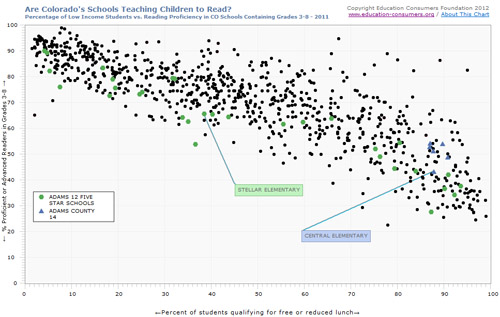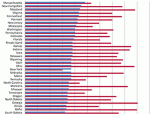Colorado: Comparing schools and districts based on student proficiency
The information below reflects the most recent data available to us; please contact us with questions or to request additional analyses.

Analysis: Comparing schools and districts on third grade proficiency in reading and math
The charts linked below allow you to compare schools and districts in Colorado with their peers. The Y (vertical) axis shows the percentage of proficient 3rd graders in a subject; the X (horizontal) axis shows the percentage of students who qualify for the free or reduced rate lunch program, a common indicator of poverty in schools.
Available charts:
- Poverty versus 3rd grade reading proficiency rates (2023)
- Poverty versus 3rd grade reading proficiency rates (2022)
- Poverty versus 3rd grade reading proficiency rates (2021)
- Poverty versus 3rd grade reading proficiency rates (2019)
- Poverty versus 3rd grade reading proficiency rates (2018)
- Poverty versus 3rd grade reading proficiency rates (2017)
- Poverty versus 3rd grade reading proficiency rates (2016)
- Poverty versus 3rd grade reading proficiency rates (2015)
- Poverty versus 3rd grade reading proficiency rates (2014)
- Poverty versus 3rd grade reading proficiency rates (2013)
- Poverty versus elementary grades reading proficiency rates (2012)
- Poverty versus elementary grades reading proficiency rates (2011)
Note: Colorado began using the PARCC assessment in 2015. Previous year results should not be compared to the 2015 and subsequent assessments.
Note: The PARCC assessment reports five levels of proficiency. The top two levels of proficiency were used for this chart.
Note: For a small number of schools in Colorado for 2015, proficiency was reported with a less than (<) or greater than (>) sign in front of the proficiency percent. These signs were removed for graphing purposes.
Note: Colorado proficiency scores for the 2011 and 2012 chart’s are for the entire school, not just the 3rd grade.
 Comparing Colorado’s Proficiency Standards to the National “Gold Standard” (NAEP)
Comparing Colorado’s Proficiency Standards to the National “Gold Standard” (NAEP)
Each state defines for itself what “proficient” means; some states have a rigorous definition, while others are less strict in their standards. To see how states compare, ECF has published charts showing the percentage of students deemed proficient in various subjects and grade levels and compared them to percentages reported for each state by the National Assessment of Educational Progress (NAEP, or “The Nation’s Report Card”), considered to be the gold standard.
